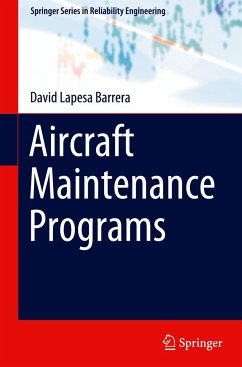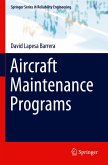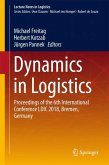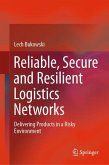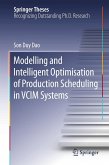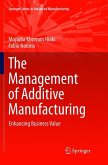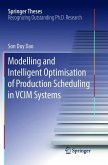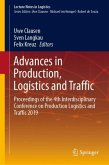David Lapesa Barrera
Aircraft Maintenance Programs
David Lapesa Barrera
Aircraft Maintenance Programs
- Gebundenes Buch
- Merkliste
- Auf die Merkliste
- Bewerten Bewerten
- Teilen
- Produkt teilen
- Produkterinnerung
- Produkterinnerung
This book provides the first comprehensive comparison of the Aircraft Maintenance Program (AMP) requirements of the two most widely known aviation regulators: the European Aviation Safety Agency (EASA) and the Federal Aviation Administration (FAA). It offers an in-depth examination of the elements of an AMP, explaining the aircraft accident investigations and events that have originated and modelled the current rules.
By introducing the Triangle of Airworthiness model (Reliability, Quality and Safety), the book enables easier understanding of the processes by which an aircraft and its…mehr
Andere Kunden interessierten sich auch für
![Aircraft Maintenance Programs Aircraft Maintenance Programs]() David Lapesa BarreraAircraft Maintenance Programs86,99 €
David Lapesa BarreraAircraft Maintenance Programs86,99 €![Dynamics in Logistics Dynamics in Logistics]() Dynamics in Logistics151,99 €
Dynamics in Logistics151,99 €![Reliable, Secure and Resilient Logistics Networks Reliable, Secure and Resilient Logistics Networks]() Lech BukowskiReliable, Secure and Resilient Logistics Networks76,99 €
Lech BukowskiReliable, Secure and Resilient Logistics Networks76,99 €![Modelling and Intelligent Optimisation of Production Scheduling in VCIM Systems Modelling and Intelligent Optimisation of Production Scheduling in VCIM Systems]() Son Duy DaoModelling and Intelligent Optimisation of Production Scheduling in VCIM Systems76,99 €
Son Duy DaoModelling and Intelligent Optimisation of Production Scheduling in VCIM Systems76,99 €![The Management of Additive Manufacturing The Management of Additive Manufacturing]() Mojtaba Khorram NiakiThe Management of Additive Manufacturing65,99 €
Mojtaba Khorram NiakiThe Management of Additive Manufacturing65,99 €![Modelling and Intelligent Optimisation of Production Scheduling in VCIM Systems Modelling and Intelligent Optimisation of Production Scheduling in VCIM Systems]() Son Duy DaoModelling and Intelligent Optimisation of Production Scheduling in VCIM Systems76,99 €
Son Duy DaoModelling and Intelligent Optimisation of Production Scheduling in VCIM Systems76,99 €![Advances in Production, Logistics and Traffic Advances in Production, Logistics and Traffic]() Advances in Production, Logistics and Traffic151,99 €
Advances in Production, Logistics and Traffic151,99 €-
-
-
This book provides the first comprehensive comparison of the Aircraft Maintenance Program (AMP) requirements of the two most widely known aviation regulators: the European Aviation Safety Agency (EASA) and the Federal Aviation Administration (FAA). It offers an in-depth examination of the elements of an AMP, explaining the aircraft accident investigations and events that have originated and modelled the current rules.
By introducing the Triangle of Airworthiness model (Reliability, Quality and Safety), the book enables easier understanding of the processes by which an aircraft and its components are deemed to be in a safe condition for operation from a cost-effective and optimization perspective. The book compares the best practices used by top airlines and compiles a series of tools and techniques to improve the standards of the AMP.
Aircraft maintenance engineers, students in the field of aerospace engineering, and airlines staff, as well as researchers more widely interested in safety, quality, and reliability will benefit from reading this book
By introducing the Triangle of Airworthiness model (Reliability, Quality and Safety), the book enables easier understanding of the processes by which an aircraft and its components are deemed to be in a safe condition for operation from a cost-effective and optimization perspective. The book compares the best practices used by top airlines and compiles a series of tools and techniques to improve the standards of the AMP.
Aircraft maintenance engineers, students in the field of aerospace engineering, and airlines staff, as well as researchers more widely interested in safety, quality, and reliability will benefit from reading this book
Produktdetails
- Produktdetails
- Springer Series in Reliability Engineering
- Verlag: Springer / Springer International Publishing / Springer, Berlin
- Artikelnr. des Verlages: 978-3-030-90262-9
- Seitenzahl: 392
- Erscheinungstermin: 17. Februar 2022
- Englisch
- Abmessung: 241mm x 160mm x 27mm
- Gewicht: 752g
- ISBN-13: 9783030902629
- ISBN-10: 3030902625
- Artikelnr.: 62631766
- Herstellerkennzeichnung
- Springer-Verlag GmbH
- Tiergartenstr. 17
- 69121 Heidelberg
- ProductSafety@springernature.com
- Springer Series in Reliability Engineering
- Verlag: Springer / Springer International Publishing / Springer, Berlin
- Artikelnr. des Verlages: 978-3-030-90262-9
- Seitenzahl: 392
- Erscheinungstermin: 17. Februar 2022
- Englisch
- Abmessung: 241mm x 160mm x 27mm
- Gewicht: 752g
- ISBN-13: 9783030902629
- ISBN-10: 3030902625
- Artikelnr.: 62631766
- Herstellerkennzeichnung
- Springer-Verlag GmbH
- Tiergartenstr. 17
- 69121 Heidelberg
- ProductSafety@springernature.com
David Lapesa Barrera is an Aeronautical Engineer specialized in Continuing Airworthiness management, and more specifically, in Aircraft Maintenance Programs. He has worked for several top airlines managing the AMP of diverse aircraft types, including the program of the Airbus A220 aircraft, the former Bombardier C Series, for the first operator, and the largest Airbus A380 fleet worldwide. It is noteworthy that he received an award from the middle east largest airline in recognition of support on the A380 C Check Optimization Project for being delivered accurately with minimum disruption and leading to maximum yield in terms of financial and hangar utilization savings. David has ISO 9001 Lead Auditor training and has been also recognized for its good practices and interest in quality and safety, being member of the International Society of Air Safety Investigators (ISASI).
Introduction.- Part I: Regulatory Environment.- ICAO and the Aviation Authorities.- The Story of Airworthiness Approvals and Certifications.- Continuing Airworthiness Management - Organization and AMP Requirements.- Instructions for Continuing Airworthiness (ICA).- Part II: Aircraft Maintenance Programs: Content and Management.- AMP Content & Maintenance Planning Document (MPD).- AMP Primary Sources.- AMP Secondary Sources: Ageing Aircraft.- AMP Secondary Sources: MCAI. Modifications, Repairs and Non-Mandatory Recommendations.- AMP Secondary Sources: Operational Requirements and Changes to the Operation Type.- Components Maintenance Program.- AMP Task Interval Management.- AMP Evolution/Optimization.- Maintenance Checks and Bridge Programs.- Aircraft Induction.- Critical Maintenance Tasks/Required Inspection Items.- Part III: The Reliability Program.- Reliability Program Regulatory Requirements.- Reliability Program Process.- AMP Task Effectiveness.- Reliability Analysis Results.- PartIV: The AMP in the Engineering & Maintenance Organization Context.- The Engineering & Maintenance Organization.- Interface of the Maintenance Program with Other Functions.- Impact of the AMP Revision on the Organization.- Part V: Safety Management: Hazards and Safety Risks.- Human Factors.- Organizational Factors.- Safety Programs.- Part V: Quality Improvement Tools and Methods.- Audits.- Problem Solving.- Continuous Improvement Methodologies and Tools.- Decision Making.- Innovation.
Introduction.
Part 1: Regulatory environment.
ICAO and the aviation authorities.
The story of airworthiness approvals and certifications.
Continuing airworthiness management – organization and amp requirements.
Instructions for continuing airworthiness (ICA).
Part 2: Aircraft maintenance programs: Content and management.
AMP content & maintenance planning document (MPD).
AMP primary sources.
AMP secondary sources: Ageing aircraft.
AMP secondary sources: MCAI, modifications & repairs and non
mandatory recommendations.
AMP secondary sources: Operational requirements and changes to the operation type.
Components maintenance program.
AMP task interval management.
AMP evolution / optimization.
Maintenance checks and bridge programs.
Aircraft induction.
Critical maintenance tasks / required inspection items.
Part 3: The reliability program.
Reliability program regulatory requirements.
Reliability program process.
AMP task effectiveness.
Reliability analysis results.
Part 4: The AMP in the engineering & maintenance organization context.
The engineering & maintenance organization.
Interface of the maintenance program with other functions.
Impact of the AMP revision on the organization.
Part 5: Safety management.
Hazards and safety risks.
Human factors.
Organizational factors.
Safety programs.
Part 6: Information security management.
Threats, vulnerabilities, and information security risks.
Aircraft information security ecosystem.
Airworthiness of aircraft information systems, networks, and equipment.
Information security programs.
Part 7: Improvement tools and methods.
Audits.
Continuous improvement methodologies.
Process mapping & analysis.
Tools for continuous improvement.
Problem
solving.
Efficiency & visual management.
Data
driven decisions.
Part 8: The future of aircraft maintenance.
Condition
based maintenance (CBM).
MSG
4: The future of aircraft maintenance.
Automation.
Paperless aircraft operations & blockchain.
Part 1: Regulatory environment.
ICAO and the aviation authorities.
The story of airworthiness approvals and certifications.
Continuing airworthiness management – organization and amp requirements.
Instructions for continuing airworthiness (ICA).
Part 2: Aircraft maintenance programs: Content and management.
AMP content & maintenance planning document (MPD).
AMP primary sources.
AMP secondary sources: Ageing aircraft.
AMP secondary sources: MCAI, modifications & repairs and non
mandatory recommendations.
AMP secondary sources: Operational requirements and changes to the operation type.
Components maintenance program.
AMP task interval management.
AMP evolution / optimization.
Maintenance checks and bridge programs.
Aircraft induction.
Critical maintenance tasks / required inspection items.
Part 3: The reliability program.
Reliability program regulatory requirements.
Reliability program process.
AMP task effectiveness.
Reliability analysis results.
Part 4: The AMP in the engineering & maintenance organization context.
The engineering & maintenance organization.
Interface of the maintenance program with other functions.
Impact of the AMP revision on the organization.
Part 5: Safety management.
Hazards and safety risks.
Human factors.
Organizational factors.
Safety programs.
Part 6: Information security management.
Threats, vulnerabilities, and information security risks.
Aircraft information security ecosystem.
Airworthiness of aircraft information systems, networks, and equipment.
Information security programs.
Part 7: Improvement tools and methods.
Audits.
Continuous improvement methodologies.
Process mapping & analysis.
Tools for continuous improvement.
Problem
solving.
Efficiency & visual management.
Data
driven decisions.
Part 8: The future of aircraft maintenance.
Condition
based maintenance (CBM).
MSG
4: The future of aircraft maintenance.
Automation.
Paperless aircraft operations & blockchain.
Introduction.- Part I: Regulatory Environment.- ICAO and the Aviation Authorities.- The Story of Airworthiness Approvals and Certifications.- Continuing Airworthiness Management - Organization and AMP Requirements.- Instructions for Continuing Airworthiness (ICA).- Part II: Aircraft Maintenance Programs: Content and Management.- AMP Content & Maintenance Planning Document (MPD).- AMP Primary Sources.- AMP Secondary Sources: Ageing Aircraft.- AMP Secondary Sources: MCAI. Modifications, Repairs and Non-Mandatory Recommendations.- AMP Secondary Sources: Operational Requirements and Changes to the Operation Type.- Components Maintenance Program.- AMP Task Interval Management.- AMP Evolution/Optimization.- Maintenance Checks and Bridge Programs.- Aircraft Induction.- Critical Maintenance Tasks/Required Inspection Items.- Part III: The Reliability Program.- Reliability Program Regulatory Requirements.- Reliability Program Process.- AMP Task Effectiveness.- Reliability Analysis Results.- PartIV: The AMP in the Engineering & Maintenance Organization Context.- The Engineering & Maintenance Organization.- Interface of the Maintenance Program with Other Functions.- Impact of the AMP Revision on the Organization.- Part V: Safety Management: Hazards and Safety Risks.- Human Factors.- Organizational Factors.- Safety Programs.- Part V: Quality Improvement Tools and Methods.- Audits.- Problem Solving.- Continuous Improvement Methodologies and Tools.- Decision Making.- Innovation.
Introduction.
Part 1: Regulatory environment.
ICAO and the aviation authorities.
The story of airworthiness approvals and certifications.
Continuing airworthiness management – organization and amp requirements.
Instructions for continuing airworthiness (ICA).
Part 2: Aircraft maintenance programs: Content and management.
AMP content & maintenance planning document (MPD).
AMP primary sources.
AMP secondary sources: Ageing aircraft.
AMP secondary sources: MCAI, modifications & repairs and non
mandatory recommendations.
AMP secondary sources: Operational requirements and changes to the operation type.
Components maintenance program.
AMP task interval management.
AMP evolution / optimization.
Maintenance checks and bridge programs.
Aircraft induction.
Critical maintenance tasks / required inspection items.
Part 3: The reliability program.
Reliability program regulatory requirements.
Reliability program process.
AMP task effectiveness.
Reliability analysis results.
Part 4: The AMP in the engineering & maintenance organization context.
The engineering & maintenance organization.
Interface of the maintenance program with other functions.
Impact of the AMP revision on the organization.
Part 5: Safety management.
Hazards and safety risks.
Human factors.
Organizational factors.
Safety programs.
Part 6: Information security management.
Threats, vulnerabilities, and information security risks.
Aircraft information security ecosystem.
Airworthiness of aircraft information systems, networks, and equipment.
Information security programs.
Part 7: Improvement tools and methods.
Audits.
Continuous improvement methodologies.
Process mapping & analysis.
Tools for continuous improvement.
Problem
solving.
Efficiency & visual management.
Data
driven decisions.
Part 8: The future of aircraft maintenance.
Condition
based maintenance (CBM).
MSG
4: The future of aircraft maintenance.
Automation.
Paperless aircraft operations & blockchain.
Part 1: Regulatory environment.
ICAO and the aviation authorities.
The story of airworthiness approvals and certifications.
Continuing airworthiness management – organization and amp requirements.
Instructions for continuing airworthiness (ICA).
Part 2: Aircraft maintenance programs: Content and management.
AMP content & maintenance planning document (MPD).
AMP primary sources.
AMP secondary sources: Ageing aircraft.
AMP secondary sources: MCAI, modifications & repairs and non
mandatory recommendations.
AMP secondary sources: Operational requirements and changes to the operation type.
Components maintenance program.
AMP task interval management.
AMP evolution / optimization.
Maintenance checks and bridge programs.
Aircraft induction.
Critical maintenance tasks / required inspection items.
Part 3: The reliability program.
Reliability program regulatory requirements.
Reliability program process.
AMP task effectiveness.
Reliability analysis results.
Part 4: The AMP in the engineering & maintenance organization context.
The engineering & maintenance organization.
Interface of the maintenance program with other functions.
Impact of the AMP revision on the organization.
Part 5: Safety management.
Hazards and safety risks.
Human factors.
Organizational factors.
Safety programs.
Part 6: Information security management.
Threats, vulnerabilities, and information security risks.
Aircraft information security ecosystem.
Airworthiness of aircraft information systems, networks, and equipment.
Information security programs.
Part 7: Improvement tools and methods.
Audits.
Continuous improvement methodologies.
Process mapping & analysis.
Tools for continuous improvement.
Problem
solving.
Efficiency & visual management.
Data
driven decisions.
Part 8: The future of aircraft maintenance.
Condition
based maintenance (CBM).
MSG
4: The future of aircraft maintenance.
Automation.
Paperless aircraft operations & blockchain.

